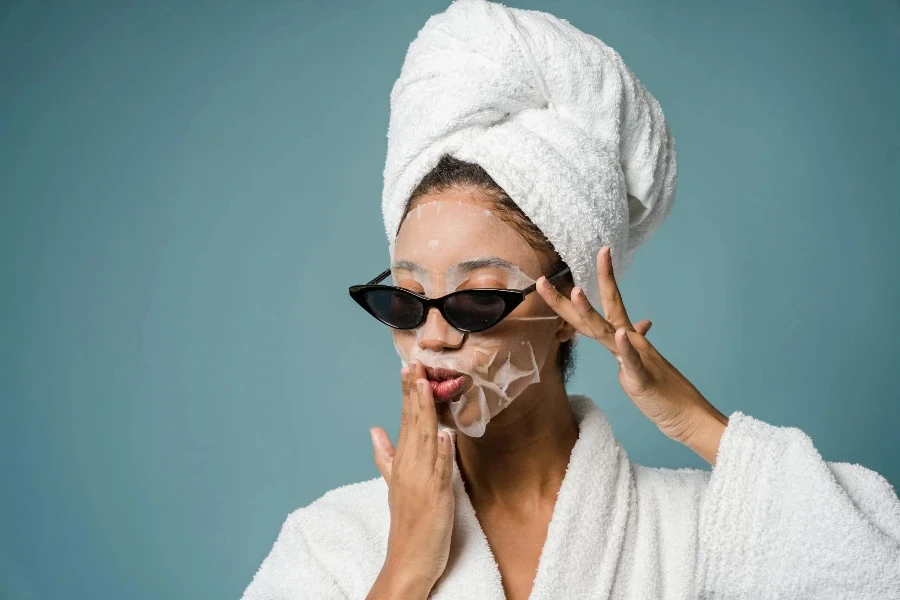Facial cleansers have become an essential part of daily skincare routines, reflecting a significant shift in consumer awareness and preferences. As the demand for effective skincare solutions grows, the facial cleanser market has evolved, offering a wide range of products tailored to various skin types and concerns. This article delves into the rise of facial cleansers, the industry’s evolution, key market players, and consumer demographics shaping this dynamic market.
Table of Contents:
– Market Overview: Understanding the Facial Cleanser Industry
– The Surge in Demand for Natural and Organic Facial Cleansers
– The Popularity of Customized and Personalized Facial Cleansers
– The Growing Interest in Multi-Functional Facial Cleansers
– Wrapping Up: Key Takeaways on Facial Cleanser Trends and Future Outlook
Market Overview: Understanding the Facial Cleanser Industry

The Evolution of Facial Cleansers: From Basic Soap to Advanced Formulations
The journey of facial cleansers from basic soap to sophisticated formulations is a testament to the advancements in skincare science and technology. Initially, facial cleansing was a simple process involving the use of soap and water. However, as understanding of skin biology and the impact of environmental factors on skin health grew, so did the need for more specialized cleansing products. Today, the market offers a plethora of options, including gel, foam, cream, oil, and micellar water cleansers, each designed to address specific skin concerns and types. According to a professional report, the global facial cleanser market is projected to reach $15.8 billion by 2030, growing at a CAGR of 6.3% from 2024 to 2030. This growth is driven by increasing consumer awareness about skincare, the rise in disposable income, and the demand for products that offer both efficacy and gentleness.
Key Players and Brands Shaping the Market
The facial cleanser market is highly competitive, with several key players driving innovation and setting trends. Major brands such as L’Oréal S.A., Johnson & Johnson, Beiersdorf AG, Kao Corporation, Shiseido Group Companies, The Estée Lauder Companies Inc., and Unilever dominate the market. These companies invest heavily in research and development to create advanced formulations that cater to the evolving needs of consumers. For instance, L’Oréal’s extensive portfolio includes products that incorporate cutting-edge ingredients like hyaluronic acid and retinols, known for their anti-aging properties. Similarly, Johnson & Johnson’s Clean & Clear line targets younger demographics with products designed to combat acne and oily skin. The competitive landscape is further enriched by emerging brands that focus on natural and organic ingredients, appealing to the growing segment of eco-conscious consumers.
Consumer Demographics and Preferences in Facial Cleansers
Understanding consumer demographics and preferences is crucial for brands to tailor their products effectively. The facial cleanser market caters to a diverse audience, including different age groups, genders, and skin types. A report by Research and Markets highlights that the personal use segment is expected to witness the highest growth due to increasing awareness of skincare among consumers. Additionally, the foam type facial cleanser segment is anticipated to remain the largest, driven by its superior cleansing and moisturizing properties. Regional preferences also play a significant role, with North America emerging as the fastest-growing segment due to heightened skincare awareness and evolving beauty trends. In contrast, the Asia-Pacific region, particularly countries like China, Japan, and South Korea, continues to lead in market size, driven by a large population base and increasing disposable income.
In conclusion, the facial cleanser industry has undergone significant transformation, driven by advancements in skincare science, consumer awareness, and the competitive efforts of key market players. As the market continues to evolve, understanding these dynamics will be essential for brands to stay ahead and meet the diverse needs of their consumers.
The Surge in Demand for Natural and Organic Facial Cleansers

In recent years, there has been a significant shift in consumer preferences towards natural and organic facial cleansers. This trend is driven by a growing awareness of the potential harmful effects of synthetic ingredients and a desire for more sustainable and eco-friendly products. Consumers are increasingly opting for facial cleansers that contain natural ingredients, which are perceived to be safer and more beneficial for the skin.
One of the primary reasons consumers are gravitating towards natural ingredients is the rising concern over the long-term effects of synthetic chemicals. Many conventional facial cleansers contain ingredients such as parabens, sulfates, and artificial fragrances, which can cause skin irritation and other health issues. In contrast, natural ingredients like aloe vera, chamomile, and green tea are known for their soothing and healing properties, making them a popular choice among consumers seeking gentle and effective skincare solutions.
Popular natural ingredients in facial cleansers include essential oils, botanical extracts, and plant-based surfactants. Essential oils like tea tree oil and lavender oil are valued for their antibacterial and anti-inflammatory properties, while botanical extracts such as chamomile and calendula provide soothing and calming effects. Plant-based surfactants, derived from sources like coconut oil and sugar, offer a mild yet effective cleansing action without stripping the skin of its natural oils.
The impact of organic certification on consumer trust cannot be overstated. Products that carry organic certifications from reputable organizations, such as USDA Organic or Ecocert, are perceived as more trustworthy and reliable. These certifications assure consumers that the products meet stringent standards for organic farming and production, free from synthetic pesticides, fertilizers, and genetically modified organisms (GMOs). As a result, consumers are more likely to choose certified organic facial cleansers, confident in their safety and efficacy.
The Popularity of Customized and Personalized Facial Cleansers

The skincare industry is witnessing a surge in demand for customized and personalized facial cleansers, driven by advancements in technology and a growing desire for tailored skincare solutions. Consumers are increasingly seeking products that cater to their unique skin types and concerns, leading to the rise of personalized skincare.
Technology plays a crucial role in enabling personalized skincare solutions. Innovations such as artificial intelligence (AI) and augmented reality (AR) are transforming the way consumers interact with skincare products. For instance, L’Oréal Paris’ ModiFace technology and Garnier’s Skin Coach tool offer AI-powered personalized skincare consultations. By simply taking a selfie, consumers can receive a customized skincare routine based on their skin type and specific needs.
Skin analysis tools are also instrumental in customizing facial cleansers. These tools, which can be found in both online and offline settings, analyze various skin parameters such as hydration levels, oil production, and sensitivity. Based on the analysis, consumers receive recommendations for facial cleansers that are best suited to their skin. This personalized approach ensures that consumers are using products that address their individual skin concerns, leading to better results and higher satisfaction.
Consumer response to personalized skincare products has been overwhelmingly positive. Personalized skincare not only meets the specific needs of consumers but also enhances their overall skincare experience. The ability to receive tailored recommendations and products instills a sense of trust and confidence in the brand. As a result, consumers are more likely to remain loyal to brands that offer personalized skincare solutions, driving long-term customer retention and brand loyalty.
The Growing Interest in Multi-Functional Facial Cleansers

Multi-functional facial cleansers are gaining popularity as consumers seek products that offer multiple skincare benefits in a single step. This trend is driven by the desire for simplified skincare routines and the need for products that deliver comprehensive results.
Combining cleansing with additional skincare benefits is a key feature of multi-functional facial cleansers. These products not only cleanse the skin but also provide benefits such as exfoliation, hydration, and anti-aging. For example, a facial cleanser with exfoliating properties can help remove dead skin cells and unclog pores, while a hydrating cleanser can replenish moisture and improve skin texture.
Popular multi-functional ingredients and their benefits include hyaluronic acid, glycolic acid, and niacinamide. Hyaluronic acid is known for its hydrating properties, helping to retain moisture and plump the skin. Glycolic acid, an alpha hydroxy acid (AHA), offers gentle exfoliation, promoting cell turnover and revealing smoother, brighter skin. Niacinamide, a form of vitamin B3, provides anti-inflammatory and anti-aging benefits, reducing redness and improving skin elasticity.
Multi-functional products are changing skincare routines by offering convenience and efficiency. Consumers no longer need to use multiple products to achieve their desired skincare results. Instead, they can rely on a single multi-functional cleanser that addresses various skin concerns. This streamlined approach not only saves time but also reduces the complexity of skincare routines, making it easier for consumers to maintain consistent skincare habits.
Wrapping Up: Key Takeaways on Facial Cleanser Trends and Future Outlook

The facial cleanser market is evolving rapidly, driven by consumer demand for natural and organic ingredients, personalized skincare solutions, and multi-functional products. As consumers become more informed and discerning, brands must adapt to these trends to stay competitive.
The surge in demand for natural and organic facial cleansers highlights the importance of transparency and sustainability in skincare. Brands that prioritize natural ingredients and obtain organic certifications are likely to gain consumer trust and loyalty.
The popularity of customized and personalized facial cleansers underscores the need for technology-driven solutions that cater to individual skin needs. Brands that leverage AI and skin analysis tools to offer personalized recommendations will stand out in the crowded skincare market.
The growing interest in multi-functional facial cleansers reflects the consumer desire for convenience and efficiency. Brands that develop products with multiple skincare benefits can simplify routines and enhance the overall skincare experience for consumers.
Looking ahead, the future of facial cleansers will be shaped by these trends, with a continued focus on innovation, sustainability, and personalization. Brands that embrace these trends and prioritize consumer needs will be well-positioned for success in the dynamic skincare market.”””





 Afrikaans
Afrikaans አማርኛ
አማርኛ العربية
العربية বাংলা
বাংলা Nederlands
Nederlands English
English Français
Français Deutsch
Deutsch हिन्दी
हिन्दी Bahasa Indonesia
Bahasa Indonesia Italiano
Italiano 日本語
日本語 한국어
한국어 Bahasa Melayu
Bahasa Melayu മലയാളം
മലയാളം پښتو
پښتو فارسی
فارسی Polski
Polski Português
Português Русский
Русский Español
Español Kiswahili
Kiswahili ไทย
ไทย Türkçe
Türkçe اردو
اردو Tiếng Việt
Tiếng Việt isiXhosa
isiXhosa Zulu
Zulu